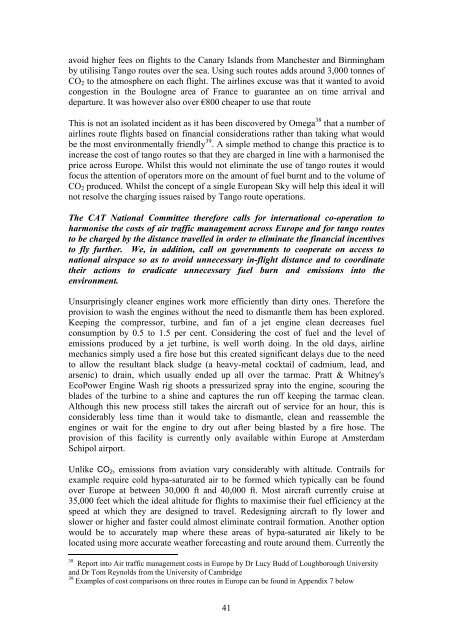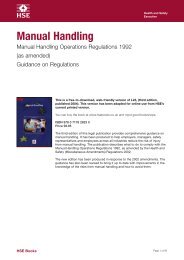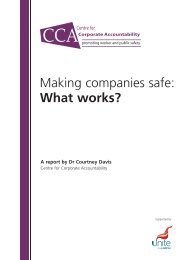Sustainable Transport and the Environment Guide - Unite the Union
Sustainable Transport and the Environment Guide - Unite the Union
Sustainable Transport and the Environment Guide - Unite the Union
Create successful ePaper yourself
Turn your PDF publications into a flip-book with our unique Google optimized e-Paper software.
avoid higher fees on flights to <strong>the</strong> Canary Isl<strong>and</strong>s from Manchester <strong>and</strong> Birmingham<br />
by utilising Tango routes over <strong>the</strong> sea. Using such routes adds around 3,000 tonnes of<br />
CO 2 to <strong>the</strong> atmosphere on each flight. The airlines excuse was that it wanted to avoid<br />
congestion in <strong>the</strong> Boulogne area of France to guarantee an on time arrival <strong>and</strong><br />
departure. It was however also over €800 cheaper to use that route<br />
This is not an isolated incident as it has been discovered by Omega 38 that a number of<br />
airlines route flights based on financial considerations ra<strong>the</strong>r than taking what would<br />
be <strong>the</strong> most environmentally friendly 39 . A simple method to change this practice is to<br />
increase <strong>the</strong> cost of tango routes so that <strong>the</strong>y are charged in line with a harmonised <strong>the</strong><br />
price across Europe. Whilst this would not eliminate <strong>the</strong> use of tango routes it would<br />
focus <strong>the</strong> attention of operators more on <strong>the</strong> amount of fuel burnt <strong>and</strong> to <strong>the</strong> volume of<br />
CO 2 produced. Whilst <strong>the</strong> concept of a single European Sky will help this ideal it will<br />
not resolve <strong>the</strong> charging issues raised by Tango route operations.<br />
The CAT National Committee <strong>the</strong>refore calls for international co-operation to<br />
harmonise <strong>the</strong> costs of air traffic management across Europe <strong>and</strong> for tango routes<br />
to be charged by <strong>the</strong> distance travelled in order to eliminate <strong>the</strong> financial incentives<br />
to fly fur<strong>the</strong>r. We, in addition, call on governments to cooperate on access to<br />
national airspace so as to avoid unnecessary in-flight distance <strong>and</strong> to coordinate<br />
<strong>the</strong>ir actions to eradicate unnecessary fuel burn <strong>and</strong> emissions into <strong>the</strong><br />
environment.<br />
Unsurprisingly cleaner engines work more efficiently than dirty ones. Therefore <strong>the</strong><br />
provision to wash <strong>the</strong> engines without <strong>the</strong> need to dismantle <strong>the</strong>m has been explored.<br />
Keeping <strong>the</strong> compressor, turbine, <strong>and</strong> fan of a jet engine clean decreases fuel<br />
consumption by 0.5 to 1.5 per cent. Considering <strong>the</strong> cost of fuel <strong>and</strong> <strong>the</strong> level of<br />
emissions produced by a jet turbine, is well worth doing. In <strong>the</strong> old days, airline<br />
mechanics simply used a fire hose but this created significant delays due to <strong>the</strong> need<br />
to allow <strong>the</strong> resultant black sludge (a heavy-metal cocktail of cadmium, lead, <strong>and</strong><br />
arsenic) to drain, which usually ended up all over <strong>the</strong> tarmac. Pratt & Whitney's<br />
EcoPower Engine Wash rig shoots a pressurized spray into <strong>the</strong> engine, scouring <strong>the</strong><br />
blades of <strong>the</strong> turbine to a shine <strong>and</strong> captures <strong>the</strong> run off keeping <strong>the</strong> tarmac clean.<br />
Although this new process still takes <strong>the</strong> aircraft out of service for an hour, this is<br />
considerably less time than it would take to dismantle, clean <strong>and</strong> reassemble <strong>the</strong><br />
engines or wait for <strong>the</strong> engine to dry out after being blasted by a fire hose. The<br />
provision of this facility is currently only available within Europe at Amsterdam<br />
Schipol airport.<br />
Unlike CO 2 , emissions from aviation vary considerably with altitude. Contrails for<br />
example require cold hypa-saturated air to be formed which typically can be found<br />
over Europe at between 30,000 ft <strong>and</strong> 40,000 ft. Most aircraft currently cruise at<br />
35,000 feet which <strong>the</strong> ideal altitude for flights to maximise <strong>the</strong>ir fuel efficiency at <strong>the</strong><br />
speed at which <strong>the</strong>y are designed to travel. Redesigning aircraft to fly lower <strong>and</strong><br />
slower or higher <strong>and</strong> faster could almost eliminate contrail formation. Ano<strong>the</strong>r option<br />
would be to accurately map where <strong>the</strong>se areas of hypa-saturated air likely to be<br />
located using more accurate wea<strong>the</strong>r forecasting <strong>and</strong> route around <strong>the</strong>m. Currently <strong>the</strong><br />
38 Report into Air traffic management costs in Europe by Dr Lucy Budd of Loughborough University<br />
<strong>and</strong> Dr Tom Reynolds from <strong>the</strong> University of Cambridge<br />
39 Examples of cost comparisons on three routes in Europe can be found in Appendix 7 below<br />
41
















